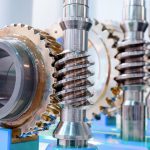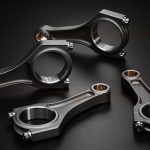Piston forming the lower part of the combustion chamber: The diesel engine is a type of internal combustion engine which ignites the fuel by injecting it into hot, high-pressure air in a combustion chamber. In common with all internal combustion engines the diesel engine operates with a fixed sequence of events, which may be achieved either in four strokes or two, a stroke being the travel of the piston between its extreme points. Each stroke is accomplished in half a revolution of the crankshaft.
Piston forms the lower part of the combustion chamber. It seals the cylinder and transmits the gas pressure to the connecting rod. The piston absorbs heat of combustion and this heat must be conducted away if the metal temperature is to kept in safe limits. The Piston comprises of two pieces; the crown and the skirt.
The crown is subject to the high temperatures in the combustion space and the surface is liable to be eroded/burnt away. For this reason the material from which the crown is made must be able to maintain its strength and resist corrosion at high temperatures.

Fig: Piston

Fig:Handling piston

Fig: Cylinder liner
Steel, alloyed with chromium and molybdenum is used, and some pistons have a special alloy welded onto the hottest part of the crown to try and reduce the erosion caused by the burning fuel. The crown also carries the 4 or 5 piston ring grooves which may be chrome plated.
The cast iron skirt acts as a guide within the cylinder liner. It is only a short skirt on engines with an exhaust valve (known as uniflow scavenged engines), as unlike a trunk piston engine, no side thrust is transmitted to the liner (that’s the job of the crosshead guides).
The stresses to which a piston is subjected to are as follows:
(mechanical & thermal stresses)
Compressive and tensile stress caused by bending action due to gas pressure
Inertia effect – movement up and downwards
Thermal stresses – rapid temperature change
The crown of a piston is subjected to a very high gas pressure which will subject the top surface of the crown to compressive loading and the lower surface of crown will be under tensile loading. The piston crown will be like a uniformly loaded beam
As the piston moving upward, towards the end of its stroke its velocity will be reducing.The inertia effect will tend to cause the piston to bow upwards, so that the surface of the crown along with sides will be under tensile loading and lower surface of the crown will be under compressive loading When the piston is retarded on its approach downwards to BDC, the inertia effect will be reversed
The thermal stresses set up in a piston are caused by the different temperature across a section.The free expansion of the hot side is restricted by the cooler surface of the piston. Maximum safe temperature at the three most critical zones for alluminium-alloy piston are Crown 370 degree to 400 degree C. Top ring groove and gudgeon pin bosses 200 degree to 220 degree C.
Mechanical and thermal stresses should be considered to gather as they tend to be complimentary to each other. Top and sometimes 2nd ring grooves is tapered up to 2 times normal axial clearance thus:
i) Clearance allows for carbon deposit
Clearance avoids piston crown edge touching liner due to thermal stress
If the crown temperature exceeds 400 degreeC, failure will probably occur from cracking. If the top ring groove temperature exceeds 220 degreeC, for any length of time, trouble may be expected from:
i)Stuck piston rings
ii) Formation of carbon at the bottom of the ring groove, causing the ring to be packed out
Cracking of crown – due to thermal and mechanical stresses. Cracking through piston wall especially in way of top ring groove – due to fluctuating gas load, excessive thermal stresses. Crack starts from inside wall. Cracking may take place due to the following reasons apart from the reasons mention above:
i) Unsuitable material for the rating of the engine or inadequate machining
ii) Excessive scaling on the cooling side, cavitaion erosion
iii) High coolant temperature
iv) Local impingement
v) Poor atomization, high penetration of fuel
vi) High water content in fuel



Comments are closed